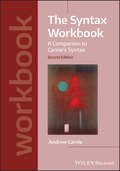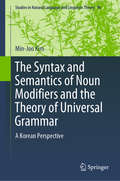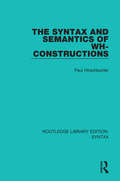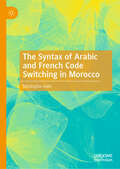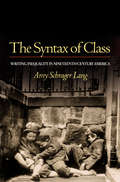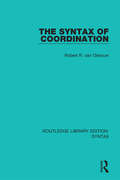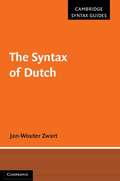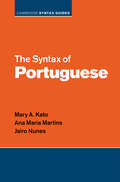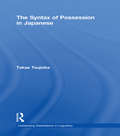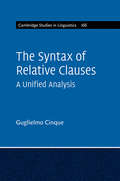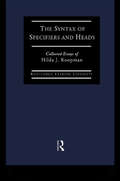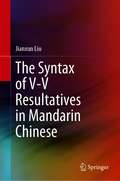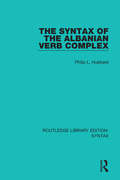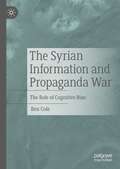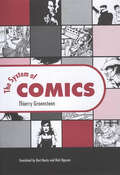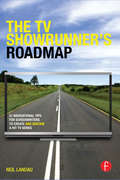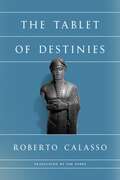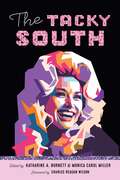- Table View
- List View
The Syntax Workbook: A Companion to Carnie's Syntax (Introducing Linguistics)
by Andrew CarnieA valuable companion to Andrew Carnie's Syntax: A Generative Introduction, 4th Edition, full of practice questions and engaging exercises to promote student comprehension Syntax: A Generative Introduction, Fourth Edition, is the leading textbook for undergraduate courses in the syntax, covering foundational topics such as universal grammar, parts of speech, constituency, trees, structural relations, binding theory, x-bar theory, and movement, as well as advanced subjects such as control theory, ellipsis, polysynthesis, incorporation, non-configurationality, and Merge. Written by Syntax author Andrew Carnie, The Syntax Workbook has been purposefully designed to support and complement the use of Syntax in the undergraduate classroom. The Syntax Workbook is the perfect companion to the author's seminal textbook and contains updated practice material for every section of the text. This workbook: Includes exercises, practice questions, data analysis, and knowledge application questions for each section in Syntax: A Generative Introduction, Fourth Edition Features exercises and questions with full answers and explanations to assist students in learning to apply theory to practice Has been authored by leading figure in syntax Andrew Carnie to support classroom usage of Syntax: A Generative Introduction, Fourth Edition Works in concert with a student companion website, offering a robust selection of learning tools for the classroom Ideal for undergraduate courses in syntax, Syntax: A Generative Introduction, Fourth Edition, and The Syntax Workbook, Second Edition, together offer a perfect combination of thorough coverage and valuable practice. The workbook can be purchased on its own or in a set with the textbook. Available as a set with Syntax: A Generative Introduction, 4th Edition
The Syntax and Semantics of Noun Modifiers and the Theory of Universal Grammar: A Korean Perspective (Studies in Natural Language and Linguistic Theory #96)
by Min-Joo KimThis book takes Korean as a basis to provide a detailed universal Determiner Phrase (DP) structure. Adnominal adjectival expressions are apparently optional noun dependents but their syntax and semantics have been shown to provide an important window on the internal structure of DP. By carefully examining data from Korean, an understudied language, as well as from other unrelated languages, the book provides a broad perspective on the phenomenon of noun modification and its cross-linguistic variations. Furthermore, it offers not only a thorough syntactic analysis but also a formal semantic analysis of noun modifiers that extends beyond a single language. This book will be of great interest to researchers interested in theoretical syntax, its interfaces with semantics, pragmatics, linguistic typology, and language variation.
The Syntax and Semantics of Wh-Constructions (Routledge Library Editions: Syntax #10)
by Paul HirschbuhlerThis title, first published in 1985, provides a detailed analysis of aspects of the semantics and the syntax of some wh-constructions. The first part of the book deals with the semantics of questions, whilst the other part discusses the syntax of que and quoi (what) in questions in French and the syntax of free relatives in French and other languages. This title will be of interest to students of language and linguistics.
The Syntax of Arabic and French Code Switching in Morocco
by Mustapha AabiThis book posits a universal syntactic constraint (FPC) for code switching, using as its basis a study of different types of code-switching between French, Moroccan Arabic and Standard Arabic in a language contact situation. After presenting the theoretical background and linguistic context under study, the author closely examines examples of syntactic constraints in the language of functional bilinguals switching between French and forms of Arabic, proposing that this hypothesis can also be applied in other comparable language contact and translanguaging contexts worldwide. This book will be of interest to students and scholars of French, Arabic, theoretical linguistics, syntax and bilingualism.
The Syntax of Class: Writing Inequality in Nineteenth-Century America
by Amy Schrager LangThe Syntax of Class explores the literary expression of the crisis of social classification that occupied U.S. public discourse in the wake of the European revolutions of 1848. Lacking a native language for expressing class differences, American writers struggled to find social taxonomies able to capture--and manage--increasingly apparent inequalities of wealth and power. As new social types emerged at midcentury and, with them, new narratives of success and failure, police and reformers alarmed the public with stories of the rise and proliferation of the "dangerous classes." At the same time, novelists as different as Maria Cummins, Nathaniel Hawthorne, Frank Webb, Elizabeth Stuart Phelps, and Horatio Alger Jr. focused their attention on dense engagements across the lines of class. Turning to the middle-class idea of "home" as a figure for social harmony and to the lexicons of race and gender in their effort to devise a syntax for the representation of class, these writers worked to solve the puzzle of inequity in their putatively classless nation. This study charts the kaleidoscopic substitution of terms through which they rendered class distinctions and follows these renderings as they circulated in and through a wider cultural discourse about the dangers of class conflict. This welcome book is a finely achieved study of the operation of class in nineteenth-century American fiction--and of its entanglements with the languages of race and gender.
The Syntax of Coordination (Routledge Library Editions: Syntax Ser.)
by Robert R. van OirsouwCoordination is a syntactic construction which occurs in most languages. In the past, it has been a fruitful area of research, but also a controversial one. Arguments from coordination have been used in support of transformations, and against phrase-structure rules, but also in support of phrase-structure rules and against transformations. This
The Syntax of Dutch
by Jan-Wouter ZwartDutch is a West-Germanic language closely related to English and German, but its special properties have long aroused interest and debate among students of syntax. This is an informative guide to the syntax of Dutch, offering an extensive survey of both the phenomena of Dutch syntax and their theoretical analyses over the years. In particular the book discusses those aspects of Dutch syntax that have played an important role in the development of syntactic theory in recent decades. Presupposing only a basic knowledge of syntax and complete with an extensive bibliography, this survey will be an important tool for students and linguists of all theoretical persuasions, and for anyone working in Germanic linguistics, linguistic typology and linguistic theory.
The Syntax of Imperatives
by Asier Alcázar Mario SaltarelliThe imperative clause is one of three major sentence types that have been found to be universal across the languages of the world. Compared to declaratives and interrogatives, the imperative type has received diverse analyses in the literature. This cutting-edge study puts forward a new linguistic theory of imperatives, arguing that categories of the speech act, specifically Speaker and Addressee, are conceptually necessary for an adequate syntactic account. The book offers compelling empirical and descriptive evidence by surveying new typological data in critical assessment of competing hypotheses towards an indexical syntax of human language. An engaging read for students and researchers interested in linguistics, philosophy and the syntax of language.
The Syntax of Negation and the Licensing of Negative Polarity Items in Hindi (Outstanding Dissertations in Linguistics)
by Rajesh KumarThis books studies syntax of NPIs and their interaction with sentential negatives in Hindi. It outlines the clause structure of Hindi and locates the syntactic position of sentential negatives as well as constituent negatives within the structure. It is argued that sentential negative in Hindi negation marker heads its own maximal projection, NegP, which is immediately dominated by TP. In addition to locating the position of negation markers in the clause structure, it outlines the distribution of negative polarity items (NPIs) in Hindi and the structural constraints on their licensing by sentential negative. The book argues that an NPI in Hindi is licensed overtly in the course of derivation by a c-commanding negative marker. The bulk of the evidence presented in this book argues against previous theoretical accounts that claim that NPI licensing involves covert syntactic operations such as LF movement or reconstruction. With respect to the classification of NPIs , this book also shows the existence of two different types of NPIs in Hindi; namely, strong NPIs and weak NPIs. Strong NPIs require a clause mate c-commanding negative licensor, whereas weak NPIs are quantifiers and are similar to free choice 'any' in English that are interpreted as NPIs in the presence of a c-commanding negative licensor.
The Syntax of Portuguese (Cambridge Syntax Guides)
by Jairo Nunes Ana Maria Martins Mary A. KatoPortuguese is the second most spoken Romance language in the world, and due to recent interest in comparative syntax, the literature on its syntax has increased exponentially, resulting in exciting discoveries of a range of aspects that have hitherto been overlooked. This book provides a theoretically grounded overview of the major syntactic properties of Portuguese, focusing on the differences between European and Brazilian Portuguese. It shows from a theoretical point of view how different syntactic properties are interconnected by comparing and contrasting the variances between pronominal and agreement systems, null subjects, null complements, and word order. It also highlights how small differences in the specification of syntactic properties may yield quite different dialects. It introduces key theoretical points without technical jargon, making the content accessible to specialist and non-specialists alike. It is essential reading for both academic researchers and students of Portuguese language, comparative syntax, Romance linguistics, and theoretical syntax.
The Syntax of Possession in Japanese (Outstanding Dissertations in Linguistics)
by Takae TsujiokaFirst Published in 2002. Routledge is an imprint of Taylor & Francis, an informa company.
The Syntax of Relative Clauses: A Unified Analysis (Cambridge Studies in Linguistics)
by Guglielmo CinqueRelative clauses play a hugely important role in analysing the structure of sentences. This book provides the first evidence that a unified analysis of the different types of relative clauses is possible - a step forward in our understanding. Using careful analyses of a wide range of languages, Cinque argues that the relative clause types can all be derived from a single, double-headed, structure. He also presents evidence that restrictive, maximalizing, ('integrated') non-restrictive, kind-defining, infinitival and participial RCs merge at different heights of the nominal extended projection. This book provides an elegant generalization about the structure of all relatives. Theoretically profound and empirically rich, it promises to radically alter the way we think about this subject for years to come.
The Syntax of Specifiers and Heads: Collected Essays of Hilda J. Koopman (Routledge Leading Linguists)
by Hilda J KoopmanSpecifiers and Heads covers such topics as: * interpretation and distribution of pronouns * ECP effects * specifiers and phrase structure * the role and functioning of head movement * the architecture of grammar Each chapter draws syntactic arguments from phenomena in a broad range of languages and brings these to bear on the structure of syntactic theory and the understanding of crosslinguistic variation. Among the languages studied are the African languages, Welsh and Irish, Norwegian, French, English and Dutch.
The Syntax of V-V Resultatives in Mandarin Chinese
by Jianxun LiuThis book addresses the three fundamental properties of V-V resultative constructions in Mandarin Chinese: their generation, their syntactic structure, and their alternations. This book is original and new in the following aspects. First, adopting the ‘inner vs. outer domain’ theory, it provides new analysis and evidence that these compounds are generated in syntax, not in lexicon. Second, this book argues that the two subclasses of V-V resultative constructions, object-oriented vs. subject-oriented V-V resultatives, actually have different structures. Their syntactic contrasts have not been observed in the literature before. Third, this book is new in determining the syntactic structure of the V-V resultative constructions through their adverbial modification properties. It demonstrates that the previous isomorphism analysis of the syntactic structure of Chinese V-V resultatives does not hold. Finally, this book provides a new analysis of the issue of the alternations of V-V resultatives. In contrast to previous analyses, which generally view the causative alternation as the idiosyncratic property of particular V-V compounds, this book provides a principled analysis. This book makes a substantial improvement of the current understanding of the issues in the syntax of Mandarin Chinese and gives new support to certain theories of the generative grammar from the perspective of Mandarin Chinese.
The Syntax of Vietnamese Tense, Aspect, and Negation
by Trang PhanThe Syntax of Vietnamese Tense, Aspect, and Negation investigates familiar grammatical phenomena including Tense, Aspect, and Negation in a theoretically understudied language, Vietnamese. The purpose of this book is to thoroughly examine how these categories are realised and how they interact with one another in Vietnamese in the spirit of Generative Grammar, in particular, the Cartographic approach to syntax and its most recently developed lexicalisation technique, Nanosyntax. It is concluded that despite lacking inflectional tense, Vietnamese does have syntactic tense, i.e., Vietnamese has those structural positions which are dedicated to Tense and Aspect. In fact, Tense and Aspect in Vietnamese are realised via a rigid fine-grained functional sequence which syntacticises subtle semantic distinctions both preverbally and post-verbally. There is a two-way complicated relationship between Negation and Aspect in Vietnamese, which can be explained in a principled way by taking into consideration how the internal syntax of the temporal, aspectual, and negative markers derives their clausal syntax. This book also discusses how Vietnamese Tense, Aspect, and Negation pattern with, and differ from, their counterparts in Western Indo-European languages, and how this study contributes to a better understanding of East and mainland Southeast Asian languages more generally, as well as of language universally. This book will be of interest to both undergraduate and postgraduate students of contemporary linguistics, and for scholars interested in contemporary approaches to Vietnamese linguistics, and Southeast Asian languages more generally.
The Syntax of the Albanian Verb Complex (Routledge Library Editions: Syntax #11)
by Philip L. HubbardThis work, first published in 1985, is an analysis of the syntax of the Albanian verb complex. The term "verb complex" is defined here as the verb stem and its conjugational endings, together with the perfect auxiliaries and verb clitics. In a wider sense the verb includes the verb and its central arguments: subject, direct object, and indirect object. The analysis is presented in a somewhat expanded version of the relational grammar framework of Perlmutter and Postal (1977). It is argued that by assuming the existence of multiple levels in the syntactic structure of a clause, it is possible to account for the distribution of active and non-active verb forms over the various constructions of Albanian with a single generalisation. This title will be of interest to students of language and linguistics.
The Syntax-Information Structure Interface: Evidence from Spanish and English (Outstanding Dissertations in Linguistics)
by Eugenia Casielles-SuárezIn the last decade, the notions of topic and focus have come to play an increasingly relevant role in theoretical linguistics. Although these notions are often taken for granted, they are still poorly understood. This study offers a detailed analysis of the precise definitions of these and related terms (theme, topic, background, given information, focus, contrast, etc.) as well as of their combination into information structures such as the topic-focus and background-focus articulations. It recommends pursuing a feature-based typology of topics and argues against a dual nature of focus (i.e. presentational vs. contrastive). Central questions addressed are the analysis of subjects in Spanish and English (DP vs NP and null vs. preverbal vs. postverbal) and the nature of constructions such as topicalization, left-dislocation, and focus preposing. Further, it is proposed that in Spanish information structure can be read off the syntax: while an overt DP in the preverbal specifier subject position is interpreted as the topic in a topic-focus articulation, one or more left-or right-dislocated phrases are interpreted as part of the background in background-focus/focus-background structures.
The Syriac World (Routledge Worlds)
by Daniel KingThis volume surveys the 'Syriac world', the culture that grew up among the Syriac-speaking communities from the second century CE and which continues to exist and flourish today, both in its original homeland of Syria and Mesopotamia, and in the worldwide diaspora of Syriac-speaking communities. The five sections examine the religion; the material, visual, and literary cultures; the history and social structures of this diverse community; and Syriac interactions with their neighbours ancient and modern. There are also detailed appendices detailing the patriarchs of the different Syriac denominations, and another appendix listing useful online resources for students. The Syriac World offers the first complete survey of Syriac culture and fills a significant gap in modern scholarship. This volume will be an invaluable resource to undergraduate and postgraduate students of Syriac and Middle Eastern culture from antiquity to the modern era.
The Syrian Information and Propaganda War: The Role of Cognitive Bias
by Ben ColeThis book focuses on the propaganda war between the Syrian government and the opposition movement, which excludes the Islamic State and the Kurdish-led SDF. Drawing on international relations, psychology, and media studies, the book encourages readers to question the dominant discourse on the war. The core of the book outlines the propaganda battles over the main paradigms and narratives that framed the war, exploring the shortcomings of those paradigms and narratives, identifying who won the propaganda war and why, and assessing what impact it had on the military side of the war. In particular, it focuses on the role of cognitive bias amongst primary and secondary sources in determining the outcome of the propaganda war, and whether the influence of this propaganda is best explained by effects or limited effects theory. Through explaining the dynamics of the propaganda war, the book encourages readers to critically question the dominant discourse on the war, assists them in understanding primary and secondary reporting on the war, and shows that the impact of the propaganda war is best understood in terms of limited effects theory. The book's main findings are that: i) the opposition won the international propaganda war but failed to win the propaganda war inside Syria; ii) propaganda had relatively little effect on shaping attitudes either inside Syria or internationally (instead, its main effect was to reinforce attitudes that had already been shaped by other factors); and iii) the reality of the war lies between the conflicting paradigms and narratives being promoted by each side.
The System of Comics
by Thierry GroensteenThis edition of Thierry Groensteen’s The System of Comics makes available in English a groundbreaking work on comics by one of the medium’s foremost scholars. In this book, originally published in France in 1999, Groensteen explains clearly the subtle, complex workings of the medium and its unique way of combining visual, verbal, spatial, and chronological expressions. The author explores the nineteenth-century pioneer Rodolphe Töpffer, contemporary Japanese creators, George Herriman’s Krazy Kat, and modern American autobiographical comics. The System of Comics uses examples from a wide variety of countries including the United States, England, Japan, France, and Argentina. It describes and analyzes the properties and functions of speech and thought balloons, panels, strips, and pages to examine methodically and insightfully the medium’s fundamental processes. From this, Groensteen develops his own coherent, overarching theory of comics, a “system” that both builds on existing studies of the “word and image” paradigm and adds innovative approaches of his own. Examining both meaning and appreciation, the book provides a wealth of ideas that will challenge the way scholars approach the study of comics. By emphasizing not simply “storytelling techniques” but also the qualities of the printed page and the reader’s engagement, the book’s approach is broadly applicable to all forms of interpreting this evolving art.
The TV Showrunner's Roadmap: 21 Navigational Tips for Screenwriters to Create and Sustain a Hit TV Series
by Neil LandauIf you’ve ever dreamed of being in charge of your own network, cable, or web series, then this is the book for you. The TV Showrunner’s Roadmap provides you with the tools for creating, writing, and managing your own hit show. Combining his 20+ years as a working screenwriter and UCLA professor, Neil Landau expertly guides you through 21 essential insights to the creation of a successful show, and takes you behind the scenes with exclusive and enlightening interviews with showrunners from some of TV’s most lauded series, including: Breaking Bad Homeland Scandal Modern Family The Walking Dead Once Upon a Time Lost House, M.D. Friday Night Lights The Good Wife From conception to final rewrite, The TV Showrunner’s Roadmap is an invaluable resource for anyone seeking to create a series that won’t run out of steam after the first few episodes. This groundbreaking guide features a companion website with additional interviews and bonus materials. www.focalpress.com/cw/landau So grab your laptop, dig out that stalled spec script, and buckle up. Welcome to the fast lane.
The TV Writer's Workbook: A Creative Approach To Television Scripts
by Ellen SandlerWhy is TV writing different from any other kind of writing? How will writing a spec script open doors? What do I have to do to get a job writing for TV? Writing for television is a business. And, like any business, there are proven strategies for success. In this unique hands-on guide, television writer and producer Ellen Sandler shares the trade secrets she learned while writing for hit shows like Everybody Loves Raymond and Coach. She offers concrete advice on everything from finding a story to getting hired on a current series.Filled with easy-to-implement exercises and practical wisdom, this ingenious how-to handbook outlines the steps for becoming a professional TV writer, starting with a winning script. Sandler explains the difference between "selling" and "telling," form and formula, theme and plot. Discover:* A technique for breaking down a show style so you're as close to being in the writing room as you can get without actually having a job there* The 3 elements for that essential Concept Line that you must havein order to create a story with passion and consequence* Mining the 7 Deadly Sins for fresh and original story lines* Sample scripts from hit shows* In-depth graphs, script breakdown charts, vital checkpointsalong the way, and much, much more!From the Trade Paperback edition.
The Tablet of Destinies
by Roberto CalassoRoberto Calasso, "a literary institution of one" (The Paris Review), tells the story of the eternal life of Utnapishtim, the savior of man, in the eleventh part of his great literary project.A long time ago, the gods grew tired of humans, who were making too much noise and disturbing their sleep, and they decided to send a Flood to destroy them. But Ea, the god of fresh underground water, didn’t agree and advised one of his favorite mortals, Utnapishtim, to build a quadrangular boat to house humans and animals. So Utnapishtim saved living creatures from the Flood. Rather than punish Utnapishtim, Enlil, king of the gods, granted him eternal life and banished him to the island of Dilmun. Thousands of years later, Sindbad the Sailor is shipwrecked on that very same island, and the two begin a conversation about courage, loss, salvation, and sacrifice. What Utnapishtim tells Sindbad is the subject of this book, the eleventh part of Roberto Calasso’s great opus that began in 1983 with The Ruin of Kasch. The Tablet of Destinies, a continuous narrative from beginning to end, delves into our earliest mythologies and records the origin stories of human civilization.
The Tacky South (Southern Literary Studies)
by Scott RomineAs a way to comment on a person’s style or taste, the word “tacky” has distinctly southern origins, with its roots tracing back to the so-called “tackies” who tacked horses on South Carolina farms prior to the Civil War. The Tacky South presents eighteen fun, insightful essays that examine connections between tackiness and the American South, ranging from nineteenth-century local color fiction and the television series Murder, She Wrote to red velvet cake and the ubiquitous influence of Dolly Parton. Charting the gender, race, and class constructions at work in regional aesthetics, The Tacky South explores what shifting notions of tackiness reveal about US culture as a whole and the role that region plays in addressing national and global issues of culture and identity.
The Tagore-Gandhi Debate on Matters of Truth and Untruth
by Bindu PuriBetween 1915 and 1941, Tagore (1861-1941) and Gandhi (1869-1948) differed and argued about many things of personal, national, and international significance---satyagraha, non-cooperation, the boycott and burning of foreign cloth, the efficacy of fasting as a means of resistance and Gandhi's mantra connecting "swaraj" and "charkha". The author tracks the development of this dialogue and argues that the debate was about more fundamental issues, such as the nature of truth and swaraj/freedom and the possibilities of untruth that Tagore saw in Gandhi's movements for truth and freedom. Puri shows that the differences between the two men's perspectives came from differently negotiated relationships to (and understandings of) tradition and modernity. Tagore was part of the Bengal renaissance and powerfully influenced by the idea that the Enlightenment consisted in the freedom of the individual to reason for herself. Gandhi, on the other hand, remained close to the Indian philosophical tradition which linked individual freedom to moral progress. Puri points out that Tagore cannot, however, be unreflectively assimilated to the Enlightenment project of Western modernity, for he came fairly close to Gandhi in rejecting the anthropocentricism of modernity and shared Gandhi's belief in an enchanted cosmos. The only single-authored volume on the Tagore-Gandhi debate, this book is a welcome addition to the existing literature.
